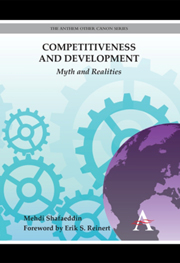Book contents
- Frontmatter
- Contents
- List of Tables, Figures and Boxes
- Foreword
- Preface
- Acknowledgements
- List of Abbreviations
- 1 Introduction: Framework of Analysis
- 2 Context and Conditions of International Competition
- 3 Alternative Theories of Competitiveness
- 4 Firm Strategy and New Industrial Organization
- 5 External Economies: Organization of Interfirm Relations
- 6 Reputation and Trust: A Firm's Relations with Stakeholders and Others
- 7 Innovation and Upgrading
- 8 Government Policies
- 9 The Experiences of China and Mexico
- 10 Summary and Concluding Remarks
- Appendices
- Bibliography
- Index
4 - Firm Strategy and New Industrial Organization
Published online by Cambridge University Press: 05 February 2013
- Frontmatter
- Contents
- List of Tables, Figures and Boxes
- Foreword
- Preface
- Acknowledgements
- List of Abbreviations
- 1 Introduction: Framework of Analysis
- 2 Context and Conditions of International Competition
- 3 Alternative Theories of Competitiveness
- 4 Firm Strategy and New Industrial Organization
- 5 External Economies: Organization of Interfirm Relations
- 6 Reputation and Trust: A Firm's Relations with Stakeholders and Others
- 7 Innovation and Upgrading
- 8 Government Policies
- 9 The Experiences of China and Mexico
- 10 Summary and Concluding Remarks
- Appendices
- Bibliography
- Index
Summary
History shows that the driving force of successful capitalist development is not the perfection of the market mechanism but the building of organizational capabilities [of firms and government].
(Lazonick 1991, 8)Introduction
In order to compete in the marketplace the management of a firm should be familiar with the sources of competitiveness, follow a strategy to create value for the customers and thus enhance its revenues. The capabilities are necessary to create supply capacity, operate the firm efficiently and upgrade its activities in order to sustain its competitiveness through relocation of the rent in the value chain. The performance of the firm then would depend on its capabilities, strategies and organization of its activities and the environment in which it operates. The sources of a firm's capabilities are three-fold: its own distinctive resources (human capital and skill, technological capacity, organization, culture and strategies), and external economies. The external economies are related to the general environment in which a firm operates, including government policies and the organization of the industry in which it operates, particularly collective efficiencies involved in an industrial cluster and production sharing.
This chapter is allocated to the discussion of the organization of the firm, interfirm relations and externalities involved including factors influencing cost of production, firm's strategy and organization, and the application of new methods of production such as the flexible manufacturing system (FMS).
- Type
- Chapter
- Information
- Competitiveness and DevelopmentMyth and Realities, pp. 79 - 106Publisher: Anthem PressPrint publication year: 2012



